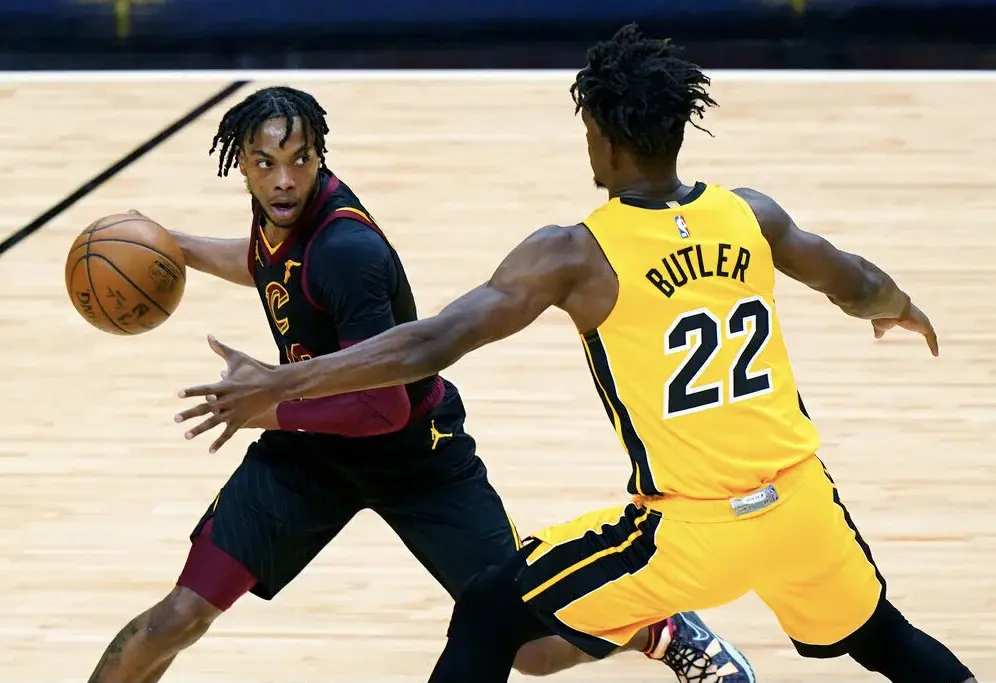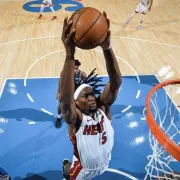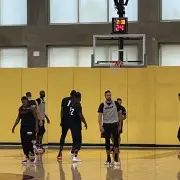A Breakdown of Miami’s Altering Defensive Schemes
The Miami Heat got another win on Tuesday night against the Cleveland Cavaliers with Jimmy Butler leading the way. Although he was the focal point of the offense for Miami, the defensive side of the ball was an all-around effort.
Instead of just mentioning the Heat are at the top of defensive rating lately, it’s necessary to dive into the exact reason for the success on that side of the ball. So, let’s take a dive into Miami’s early altering defensive schemes.
– Swarming switches into high traps into fast-break points
Half-way through the first quarter was when Miami really started to get into their natural defensive form. Early in the play, it’s another representation of a soft switch between Jimmy Butler and Bam Adebayo, since Adebayo popped out high while Butler stayed with the diving Jarrett Allen.
Collin Sexton and Larry Nance Jr tried to work a pick and roll/pick and pop set three straight times, which that third time turned into a high trap with both of Miami’s bigs. This forced Sexton to make a tough pass, especially since Kendrick Nunn rotated onto Nance, leading to a turnover.
A big part of this defense is the offense that can be generated from it, especially during a stretch that Miami struggled in the half-court. Butler makes the lead pass into a 3 on 1 opportunity, which Miami capitalizes on.
– 2-2-1 full-court press into 2-3 zone
Now, the most intriguing part about Miami’s defense last night was the 2-2-1 full-court press into the 2-3 zone. For starters, there’s a real comfort level to do this with Andre Iguodala out there, for obvious reasons. Combining active hands and high IQ movements is quite the pairing.
The press on this possession was just to put slight pressure on the ball-handler, but the zone is actually what stood out. Miami’s defensive rotations were crisp on the perimeter, meaning Cleveland was just playing catch on the three-point line.
Another aspect of this is KZ Okpala being utilized at the top of the zone, since they can rely on him to take the individual match-up when they try to iso, which on this possession almost led to a turnover. The only issue here was that they played 23 seconds of great defense, wrecking havoc out on the perimeter, but that led to easy offensive rebounds when it clanked off the rim, which will be the next touch up in practice.
Here’s another example of this exact defensive scheme. An interesting part about Iguodala and Okpala at the top of the zone is the natural switching that occurs when one notices the other getting screened.
This is yet another play where a turnover almost occurs, but McGee resets and takes it to the basket on Okpala. The issue here was that he basically let him get to the rim with ease, instead of playing a bit more physical, but still it forced a tough shot even though it went in.
Although both of these plays ended in scores for Cleveland, there are clear positives to this scheme, especially when using the same personnel that was used last night.
– Forcing the opposing team to play at an uncomfortable speed
Another element to this pressing is that it forces the offense to play at a speed that they’re not used to. It’s usually about getting into the half-court then flowing into their sets, but this forces them to make quick decisions which obviously means more mistakes.
On this play for example, they forced Cleveland into a pull-up three, 5 seconds into the shot clock. And if that doesn’t scream unorthodox offense for an inexperienced team, then I don’t know what does.
But this point that I’m making leads us right into the only downfall, which I will point out next.
– Long spurts of this defense leads to easy breakdowns
I’ve mentioned the clear positives to this Miami defense, since it can catch a team by surprise, sparking an incredible run, but let’s take a look at the part that must be touched up.
Going to this defense for too long is not a great decision to make, no matter the team you’re facing. On this play, Cleveland just came out of a timeout, and immediately broke down the press. He finds the guy at half-court, swings it to the wing, creating an easy 2 on 1 opportunity.
It was obvious the Cavs coach, J.B. Bickerstaff, was going to make this adjustment coming out of the timeout, which is why it was odd Coach Spo stayed with it at this point. Another reason I’m mentioning this is because Miami will be facing a Memphis team tonight, who has an incredible ability to breakdown defenses with Ja Morant surveying the floor. So, if Miami stays in something like this too long, it won’t end well.
– Forcing more offensive confusion
When a team is facing a zone defense that they haven’t seen since high school basketball, it’s clear it takes some time to get in any type of rhythm. As seen here, Cleveland was not getting into any type of half-court sets other than a normal pick and roll, which went absolutely no where with the continued Iguodala-Okpala top of the key switches.
Another part to mention on this play is Tyler Herro’s comfort level at the bottom of the zone. He played some possessions at the top of the key when Okpala exited, but he really looks his best when he has freedom down low to constantly help on the wing.
Here, he had two on his side of the floor, and when Cedi Osman began to dribble back out, he timed it perfectly to get back to the corner before the pass was even made. The individual defensive issues early on in the season have really been patched with this type of play.
– The zone causes constant turnovers, but gives up rebounds
The two things the zone has shown to do for Miami is lose rebounds, but also force turnovers. And against a team like Cleveland, you can take that trade off for longer stretches than usual.
Although Cleveland gets the offensive rebound on this play, take a look at their offense following that. It’s obvious a lot of their players have no idea where to stand against this defense, and sometimes means there’s not enough movement. A miscommunication occurs as Nance cuts and Osman passes, forcing yet another turnover.
The reason a lot of these plays seem repetitive is because Miami is giving a consistent effort on that end of the floor, due to the perfect rotations being made on the back-side every play. Once again, if they can continue this scheme without overusing it, good things will come from it.
Loading...









Leave a Reply
Want to join the discussion?Feel free to contribute!